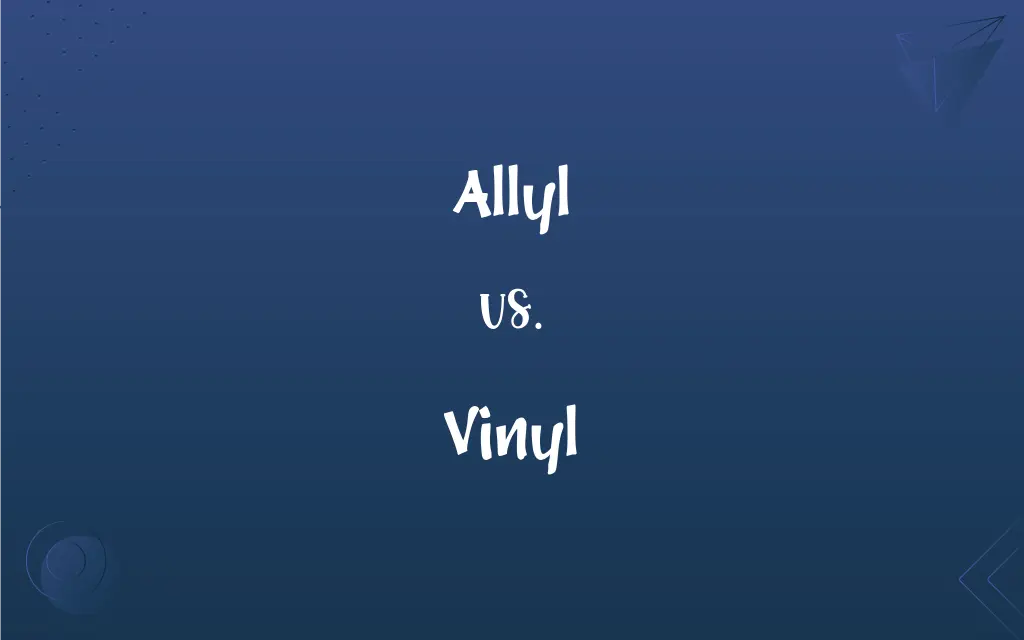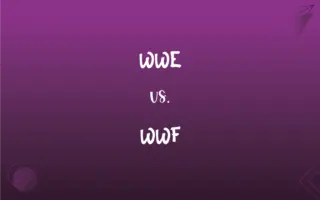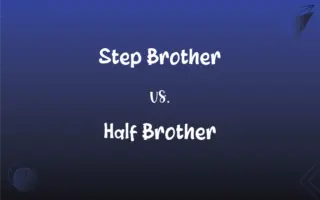Allyl vs. Vinyl: What's the Difference?
Edited by Aimie Carlson || By Harlon Moss || Updated on October 2, 2023
Allyl and Vinyl are different chemical groups; Allyl has a CH2=CH-CH2 group, while Vinyl consists of a CH2=CH group.

Key Differences
Both allyl and vinyl groups are found in organic chemistry, demonstrating distinctive structures and reactivity. Allyl is characterized by a CH2=CH-CH2 group, while vinyl is recognized for its CH2=CH group. These seemingly minor structural disparities can influence the properties and reactions that the groups undergo, with each having a unique reactivity profile that is broadly explored in organic synthesis.
Allyl groups are noted for their ability to participate in various reactions such as allylic halogenation and the Tsuji–Trost reaction. Allyl halides are often utilized as intermediates in organic synthesis, with allyl chloride being one of the most prevalent. Meanwhile, vinyl groups, with their different structural characteristics, are not involved in similar reactions as allyl groups, showcasing how chemical structure can directly correlate with chemical behavior.
With a focus on polymer production, vinyl compounds often stand out significantly. Polyvinyl chloride (PVC), for instance, is widely used in various industries due to its durability and cost-effectiveness. Contrastingly, allyl compounds aren't typically seen in polymer contexts in the same way vinyl compounds are, underscoring the broad application and utility of vinyl-containing compounds in polymer chemistry and material science.
In medicinal chemistry, allyl groups are sometimes implicated due to their bioactivity. For example, allyl isothiocyanate is responsible for the pungent nature of mustard oil. Vinyl groups, while also found in various bioactive molecules, exhibit different reactivity and thus find applications in different areas of chemical synthesis, once again underscoring the substantial impact of structural variations.
Overall, both allyl and vinyl groups enrich the scope of organic chemistry and materials science. However, their diverse structural elements and chemical behavior facilitate their utilization in different areas of research and industrial application. Thus, a robust understanding of the nuances between these groups is fundamental in optimizing their application across varied scientific and industrial domains.
ADVERTISEMENT
Comparison Chart
Basic Structure
CH2=CH-CH2
CH2=CH
Polymer Involvement
Rarely used in polymers
Common in polymers (e.g., PVC)
Use in Synthesis
Used in various syntheses due to the ability to form stable cations
Less versatile in synthesis
Presence in Nature
Found in mustard oil (allyl isothiocyanate)
Found in polyvinyl compounds (PVC)
Reaction Example
Undergoes allylic halogenation
Does not undergo allylic halogenation
ADVERTISEMENT
Allyl and Vinyl Definitions
Allyl
Allyl is a functional group with the structural formula CH2=CH-CH2.
Allyl chloride is utilized in the production of plastics.
Vinyl
Vinyl is a hydrocarbon group with a CH2=CH structure.
Vinyl flooring is popular due to its cost-effectiveness and durability.
Allyl
Allyl groups can engage in a variety of organic reactions.
Allyl isothiocyanate is a compound found in mustard oil.
Vinyl
Vinyl compounds can polymerize, forming polyvinyl compounds.
Vinyl chloride monomers can polymerize to form PVC.
Allyl
Allyl esters are utilized in the production of flavors.
Allyl hexanoate is used to create pineapple aroma.
Vinyl
The vinyl group is often found in numerous plastic materials.
Vinyl gloves are commonly used in the medical field.
Allyl
The allyl anion and cation have planar structures.
Allyl anions are intermediates in certain organic reactions.
Vinyl
Vinyl groups can be implicated in substitution and addition reactions.
Vinyl sulfone reacts with amines in addition reactions.
Allyl
Allyl compounds contain a carbon atom bonded to a methylene group that is adjacent to a double bond.
Allyl alcohol is used in the production of pharmaceuticals.
Vinyl
Vinyl compounds can participate in various addition reactions.
Vinyl acetate is used to produce polyvinyl acetate through polymerization.
Allyl
The univalent, unsaturated organic group C3H5.
Vinyl
Phonograph records considered as a group
A secondhand store that buys and sells vinyl.
Allyl
The univalent radical, CH2=CH-CH2-, existing especially in oils of garlic and mustard.
Vinyl
The univalent hydrocarbon group CH2=CH, derived from ethylene.
Allyl
An organic radical, C3H5, existing especially in oils of garlic and mustard.
Vinyl
Any of various compounds containing the vinyl group, typically highly reactive, easily polymerized, and used as basic materials for plastics.
Allyl
The univalent unsaturated organic radical C3H5; derived from propylene
Vinyl
Any of various typically tough, flexible, shiny plastics, often used for coverings and clothing.
FAQs
What is an example of an allyl compound?
Allyl chloride, a compound used in the manufacture of plastics and resins, is a notable example.
Are vinyl compounds used in medicinal applications?
Yes, certain vinyl compounds find applications in medical devices, such as IV bags and tubing made from PVC.
What common products contain vinyl?
Vinyl is found in numerous products, such as PVC pipes, vinyl records, and synthetic leather.
What is the significance of allyl and vinyl groups in organic chemistry?
Allyl and vinyl groups offer diverse reactivity profiles and are integral in the synthesis of various organic compounds, polymers, and materials.
What is an allyl group?
Allyl is a chemical group with the structure CH2=CH-CH2, often participating in various organic reactions.
How is the vinyl group defined?
Vinyl is defined by the CH2=CH group and is a key unit in various polyvinyl compounds like PVC.
Are allyl and vinyl groups identical?
No, allyl and vinyl groups have different structures and, therefore, different chemical properties and uses.
Name a polymer that contains the vinyl group.
Polyvinyl chloride (PVC) is a widely used polymer containing vinyl groups.
Is the allyl group present in any natural compounds?
Yes, for example, allyl isothiocyanate gives mustard oil its pungent aroma.
Can vinyl groups be found in consumer goods?
Yes, vinyl groups are found in consumer items like vinyl flooring, gloves, and records.
Are allyl and vinyl groups toxic?
Allyl and vinyl compounds can be toxic, depending on specific compounds and exposure levels.
Can both allyl and vinyl be found in polymers?
Vinyl is commonly found in polymers (e.g., PVC), whereas allyl is less common in polymer contexts.
How are allyl and vinyl groups relevant in industry?
Allyl is utilized in syntheses (e.g., allyl halides), while vinyl is pivotal in polymer industries (e.g., PVC production).
What reactions are allyl groups known for?
Allyl groups are known for allylic halogenation and Tsuji–Trost reaction, among others.
Are vinyl groups implicated in any pharmaceutical syntheses?
Yes, vinyl groups can participate in various chemical reactions utilized in pharmaceutical synthesis.
How is allyl involved in materials science?
Allyl compounds might be used in resins, plastics, and as intermediates in synthesizing other compounds.
Are vinyl polymers recyclable?
Yes, certain vinyl polymers, like PVC, can be recycled.
How does the reactivity of allyl and vinyl groups differ?
Allyl groups can form stable cations and undergo allylic substitution, while vinyl groups can participate in addition reactions.
Can allyl groups be found in any drugs?
Certain drugs might contain allyl groups, exploiting their ability to engage in specific organic reactions.
How is allyl used in flavor manufacturing?
Allyl esters, like allyl hexanoate, are utilized to create certain flavors and aromas.
About Author
Written by
Harlon MossHarlon is a seasoned quality moderator and accomplished content writer for Difference Wiki. An alumnus of the prestigious University of California, he earned his degree in Computer Science. Leveraging his academic background, Harlon brings a meticulous and informed perspective to his work, ensuring content accuracy and excellence.
Edited by
Aimie CarlsonAimie Carlson, holding a master's degree in English literature, is a fervent English language enthusiast. She lends her writing talents to Difference Wiki, a prominent website that specializes in comparisons, offering readers insightful analyses that both captivate and inform.































































